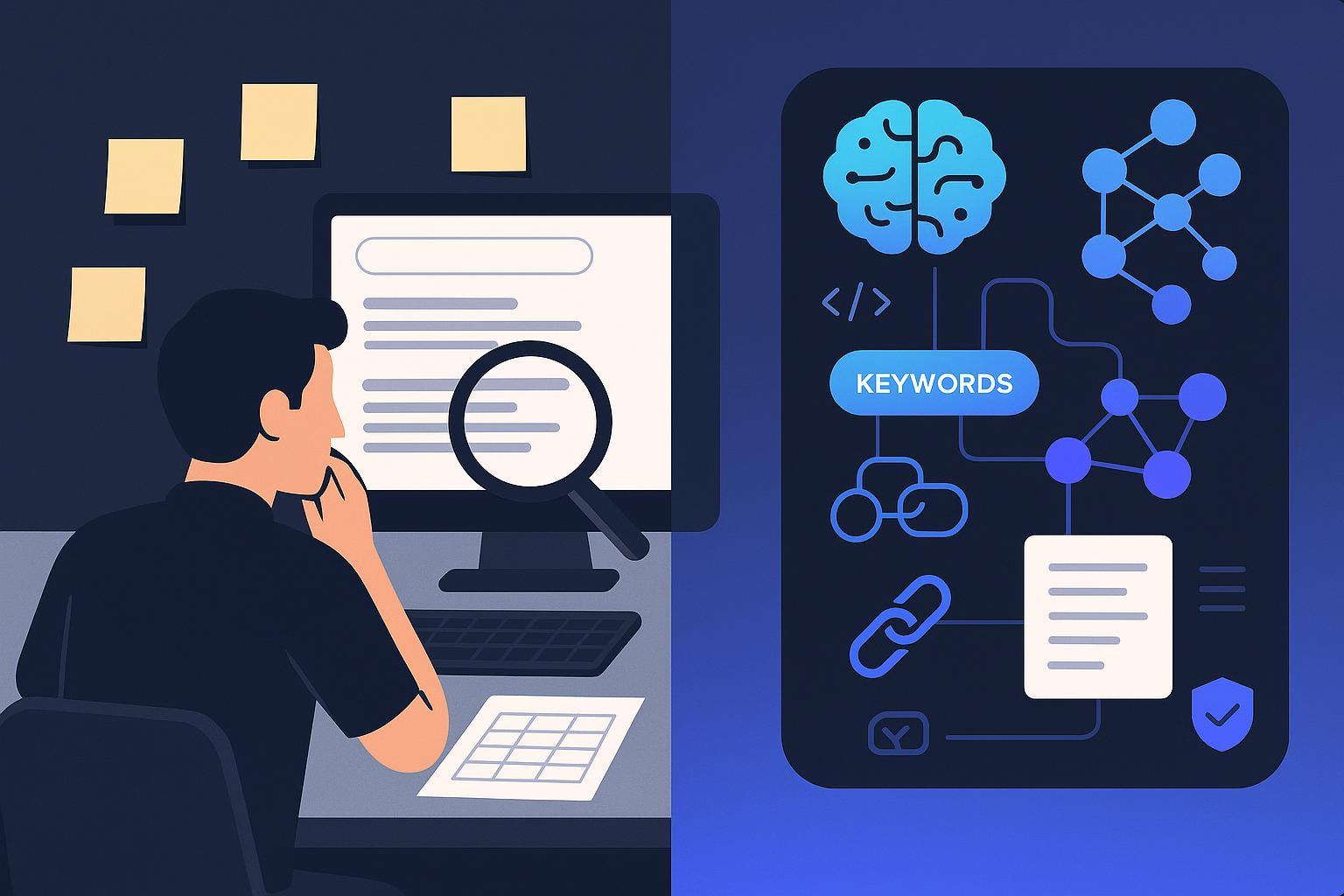What’s the difference between AI-driven SEO and traditional SEO?

If you’ve felt search shifting under your feet—more zero-click results, AI summaries at the top, and stricter quality enforcement—you’re not imagining it. Traditional SEO and AI-driven SEO share the same goal (helpful content discovered by the right audience), but they get there via very different workflows, data models, and measurement approaches. Below is a balanced look at both, with practical guidance on when each shines and how to combine them safely.
Quick definitions
- Traditional SEO: Human-led keyword research, on-page optimization, link building, and technical fixes to rank in classic SERPs. Best for nuanced brand voice, expert-reviewed content, and tightly governed sites (e.g., YMYL).
- AI-driven SEO: Uses machine learning/NLP to scale tasks like keyword/topic clustering, automated content briefs, internal linking suggestions, entity/structured data optimization, and programmatic content—targeting both classic SERPs and AI answer engines (e.g., Google’s AI Overviews/AI Mode). Often paired with Generative Engine Optimization (GEO) strategies that consider conversational queries and citation capture.
If you need help building AI-assisted workflows, you can explore tools like an AI Blog Writer and read an overview of GEO in our analysis of generative engine optimization tools.
Snapshot comparison: how the approaches differ
| Dimension | Traditional SEO | AI-driven SEO |
|---|---|---|
| Workflow | Manual research, writing, editing, and linking; slower scale | Automated clustering/briefs, internal linking, templates; faster scale but needs strong QA |
| Data & intent | Volume-based keywords, manual intent grouping | Semantic/topic clustering, entity graphs, conversational queries |
| Target surfaces | Classic SERPs, snippets, Knowledge Panels | SERPs plus AI Overviews/answer engines; emphasis on entities/citations |
| Compliance | Human editorial control; easier E-E-A-T governance | Risk of scaled content abuse; must align with E-E-A-T and spam policies |
| Measurement | Clicks, impressions, CTR, position | Traditional KPIs plus qualitative “citation capture,” branded search lift |
| Resourcing | Content strategists, SEOs, developers | Adds AI tooling and prompt/ops skills; governance and editorial QA required |
| Strengths | Nuance, brand safety, YMYL suitability | Scalability, coverage, adaptability to AI surfaces |
| Risks | Slower pace, resource-heavy | Generic/thin output if misused; hallucination/citation errors |
How workflows change in practice
-
Keyword and topic clustering
- Traditional: spreadsheets and manual grouping by intent—accurate but time-intensive.
- AI-driven: auto-clusters thousands of queries by semantic similarity to expose content gaps quickly. See examples like Nightwatch’s approach to AI keyword research.
-
Content briefs and drafting
- Traditional: editors synthesize SERP findings into briefs; writers craft content with heavy human review.
- AI-driven: auto-generated briefs include headings, entities, and competitor coverage. Human editing remains essential to ensure originality and credibility.
- For practical how-tos, check the AI blog writing guides.
-
Internal linking
- Traditional: editors add links manually; sitewide linking strategy evolves slowly.
- AI-driven: contextual link suggestions can propagate across hubs and clusters at scale—still needs human oversight to avoid over-linking or irrelevant anchors.
-
Programmatic SEO
- Traditional: hand-built landing pages; limited volume.
- AI-driven: template + data workflows can produce hundreds/thousands of pages. Quality gates (unique value, de-duplication, schema, page performance) are non-negotiable.
-
Entity optimization and structured data
- Traditional: entities often implied rather than explicitly modeled.
- AI-driven: tools identify key entities and relationships; add schema/microdata to help machines understand context. For real-world inspiration, see this microdata walkthrough: From Zero to Hero: Microdata SEO Ranking Success.
Targets and surfaces: SERPs vs AI answer engines
Traditional SEO aims at classic rankings, featured snippets, and site structures optimized for crawlability. AI-driven SEO also considers answer engines like Google’s AI Overviews and AI Mode, where entity coverage, citations, and conversational phrasing matter.
Recent industry studies suggest AI Overviews appear in a meaningful share of queries and can alter click behavior. For instance, the Semrush 2025 analysis reported ranges for AI Overview prevalence and impacts on visibility; see the details in the Semrush AI Overviews study (2025). In parallel, 2024 research by SparkToro indicated an increase in zero-click outcomes across Google, with EU and US cohorts both affected—summarized in the SparkToro 2024 zero-click study.
Compliance and quality: Google’s stance in 2024–2025
Google’s guidance permits responsible use of AI for content creation when the intent is to help users. As stated in Google’s 2023 clarification, “appropriate use of AI or automation is not against our guidelines…”—see the official note in Google Search and AI content (2023). At the same time, the March 2024 core update expanded spam policies to target scaled content abuse, site reputation abuse, and expired domain abuse. Details are in the March 2024 core update & spam policies.
Two practical reminders for teams:
- E-E-A-T is not a direct ranking factor (Google reiterates this in the SEO Starter Guide), but demonstrating expertise, experience, and trust signals remains vital for both approaches. See the reference in the Google SEO Starter Guide.
- Search Console reporting for AI features: As of 2025, AI Overviews/AI Mode traffic is included within the web Performance report—no separate filter exists. Google documents this in AI features appearance reporting.
On the technical side, remember the Core Web Vitals update: INP replaced FID on March 12, 2024, and the “good” thresholds remain LCP ≤ 2.5s, INP ≤ 200ms, CLS ≤ 0.1 at the 75th percentile. The change is covered in the web.dev INP update (2024).
For practical quality alignment, consider implementing systematic content scoring aligned to E-E-A-T. Here’s a deeper look at one framework: Elevate Your SEO with Content quality score.
Measurement: KPIs for classic SEO and AI answer engines
-
Classic SEO KPIs
- Impressions, clicks, CTR, average position (Search Console)
- Conversions, assisted conversions (analytics)
- Page-level performance (Core Web Vitals), crawl/index health
-
AI-answer engine KPIs (currently proxies)
- Citation capture: Does your page get cited in AI Overviews? Track instances manually or with third-party monitors.
- Pixel-based visibility: Position and render above/below AI elements.
- Branded search lift: If AI answers attribute you, does branded search rise over time?
- Referral quality: Downstream engagement from AI-cited links (time on page, conversion rate).
Given reporting limits, you’ll often triangulate multiple signals. As noted above, AI Overviews traffic shows up inside web Performance data in Search Console without its own filter.
When to choose which: scenario guidance
-
SMB with limited time/budget
- Blend AI-driven clustering and briefs with human editing. Prioritize evergreen, helpful content and technical hygiene. Use governance to avoid thin output.
-
Scaling content operations
- Consider programmatic SEO with strict QA: unique value per page, deduplication, schema, and fast performance. Test “citation capture” strategies with entity-rich, authoritative content.
-
Regulated/YMYL (health, finance, legal)
- Keep humans firmly in the loop: expert authorship, disclosures, rigorous fact-checking. Use AI mostly for diagnostics, outlining, and internal linking—not for final copy.
-
Recovering after core updates
- Prune thin/duplicative pages, consolidate topics, elevate E-E-A-T. Let AI assist with diagnostics (duplicate detection, cluster analysis), but keep editorial improvements human-led.
How to combine AI-driven and traditional SEO—safely
- Use AI for scale (clustering, briefs, internal linking), but have humans own strategy, POV, and editing.
- Model entities and add structured data to help machines understand context.
- Maintain a living quality standard: content scoring, expert review, source citations, original insights.
- Measure across both worlds: classic KPIs plus AI-answer proxies and branded search lift.
- Avoid scaled content abuse; anchor everything in helpfulness and originality.
For step-by-step guidance, see our overview on making SEO simpler with a practical platform workflow: Make SEO Simple with QuickCreator AI Blogging Platform.
Also consider: related alternatives
- QuickCreator — Disclosure: QuickCreator is our product. A neutral, AI-assisted blogging and SEO platform that supports multilingual drafting, SERP/topic recommendations, structured data, and content quality scoring. Useful for teams adopting hybrid workflows without heavy technical lift.
Bottom line
AI-driven SEO doesn’t replace traditional SEO—it extends it. Traditional methods remain essential for strategy, brand coherence, and compliance, while AI adds scale and adaptability for modern surfaces like AI Overviews. The winning approach is a governed hybrid: automate responsibly, publish people-first content, and measure outcomes across both classic and AI-driven search experiences.

